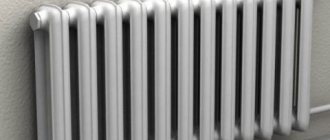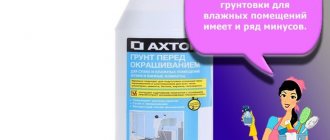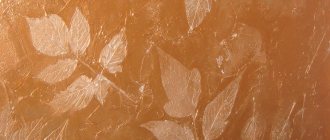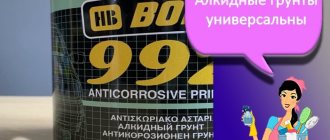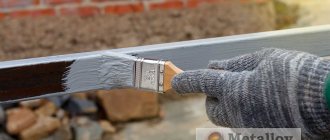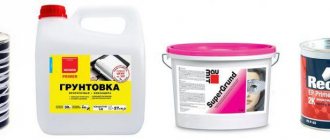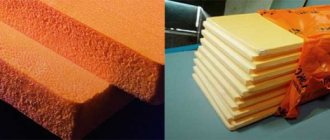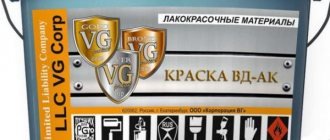Gas and foam block materials are considered durable and inexpensive products used in private construction. But their surfaces are not marketable, absorb moisture and quickly crumble if there is no proper protection, creating a “cold bridge.” To avoid this, the surface of the blocks should be treated, which will require a primer for foam blocks.
Types of primers
Depending on the method of exposure and the type of coating formed, all brands are conventionally divided into:
- Deep penetration emulsions are the most popular and widespread, having a universal scope of application.
- Surface, providing a dense film, complicating the plastering process and used when it is necessary to protect against intense moisture influences.
In general, the classification is conditional, depending on the functions performed, they are divided into universal (providing comprehensive protection of foam concrete blocks) and specialized (strengtheners, water repellents, antiseptics, tinted to prepare walls for decorative plaster). The first group is more common and economical, the second are more expensive and must be justified.
Review of popular brands
Wall primer compositions are produced by trusted domestic and foreign manufacturers. The best reviews are observed for the brands Knauf, Ivsil, Unis, Ceresit, Vetonit, Volma, Dali and Starateli.
Most of them have a universal scope of application and are suitable not only for working with porous concrete, but also for any other mineral surfaces.
1. Ceresit CT 17 universal.
A quick-drying water-dispersive primer with high penetrating ability, used before preparing foam block structures for plastering, painting or covering them with insulation. The advantages include good vapor permeability, a universal sphere, highlighting of the treated area due to its yellow color, increased adhesion, strengthening and reducing the absorption properties of the base. It is recommended to prime the walls with this composition before applying thin-layer finishing materials; it prevents them from drying out or peeling.
Acrylic primer of deep penetration, characterized by small particle size and the presence of antiseptics. It is recommended to buy this brand if you need to strengthen or reduce absorbency before subsequent finishing. Its use allows you to avoid the formation of unpleasant odors and mold colonies, regardless of the place of treatment: on internal walls or facades). The soil is a concentrate and is diluted with water, in particular this is recommended when working with particularly porous blocks.
3. Water repellent Perel Impregno Prima.
Professional silicone composition with white spirit with antiseptic additives to protect ceramic or foam concrete blocks from moisture, aggressive salts, icing and corrosion. By analogy with water-dispersive soils, it has the ability to penetrate deeply (up to 50 mm), but the drying time and water-repellent properties of this variety are much longer. Does not form a film, does not change the color of products and does not interfere with their air exchange. The resulting coating does not need to be renewed and provides protection from fungus and moisture for at least 10 years, the downside is the high consumption on porous substrates, the purchase must be justified.
Styrene-acrylate primer for foam and gas blocks, used before applying plaster to walls or placing tiles on interior and exterior work. It is characterized by increased adhesive properties, water resistance and good vapor permeability, and has antifungal properties. This primer forms a thin transparent film after drying, which contributes to the economical consumption of finishes; the best results are achieved when applied before laying gypsum plasters.
5. Vetonit.Prim Uni.
Facade acrylic primer for mineral surfaces and foam blocks with a high proportion of solids and a small filler size. This brand is a specialized one; it is recommended to buy it when preparing external walls before applying decorative plasters. The primer layer performs several functions: it reduces the absorbent qualities of foam concrete, strengthens the base and tints it to match the finishing composition. The standard color of Vetonit.Prim Uni is white, but if necessary it can be painted in any desired shade. The maximum effect is achieved when preparing facades, but due to the high environmental friendliness there are no restrictions for priming internal walls.
6. Knauf Multigrund.
Universal based on a polymer dispersion, used before preparing surfaces for laying gypsum or cement plasters, tiling or installing gypsum boards with glue. Valued for good vapor permeability, high drying speed, economical consumption on porous products and effective prevention of dehydration of finishes or adhesives, which subsequently contributes to their reliable adhesion.
Tips for choosing a primer
Preference is given to concentrated compositions, suitable for dilution before priming walls, as they are more economical. Also, when purchasing, pay attention to:
- The presence of fungicides and similar substances with antiseptic properties. Despite its good resistance to biological threats, foam concrete covered with finishing materials requires additional protection. Brands with such qualities are not much more expensive than conventional preparatory ones; their effectiveness has been proven in practice.
- Consumption indicators. Most of the deep penetration liquids sold on porous substrates are absorbed more strongly than when priming concrete or brick; you should focus on the upper limit specified by the manufacturer.
- Vapor permeability. When treating interior walls, preference is given to denser soils, but any products used must retain the ability to exchange air.
- Operating conditions, if protection from intense moisture loads or aggressive environments is necessary, only specialized hydrophobic ones are suitable.
- The color of the coating after drying, compatibility with plaster or paint. The range is represented by emulsions that prepare walls before application, but some solvent-based options are used to protect blocks before installing wall systems in conditions of high humidity.
Compositions for priming walls are sold in plastic cans and containers from 5 liters and above; approximate prices taking into account the main characteristics are given in the table:
| Name | Soil type | Consumption rate, l/m2 | Application temperature, °C | Drying time at normal. conditions, min | Capacity, l | Price, rubles |
| Ceresit CT 17 universal | Deep penetration | 0,1-0,2 | +5 to +35 | 120-240 | 10 | 680 |
| Ivsil | The same, with antifungal effect | 0,18-0,25 | +5 to +30 | 30-40 | 420 | |
| Perel Impregno Prima | Water repellent | 0,15-0,35 | -10 to +30 | 24 hours | 1980 | |
| Volma Plast | Deep penetration | 0,05-0,1 | +5 to +30 | 60 | 390 | |
| Vetonit.Prim Uni | Strengthening, facade | 0,2 | Not lower than +5 | 60-120 | 25 | 3070 |
| Knauf Multigrund | Universal, to reduce the absorption of foam concrete blocks | +5 to +30 | 360 | 5 | 470 |
Common manufacturers
The building materials market is saturated with primers of various types. If 2-3 decades ago it was difficult to find a suitable composition, now times have changed. In Russia, a number of enterprises are engaged in this.
- “Prospectors” - serial production is established on fifteen high-tech lines of the main workshops located in the Moscow region and four in other constituent entities of the Russian Federation: Ulyanovsk, Belgorod regions, Krasnodar Territory and the Republic of Buryatia.
- One of the oldest manufacturers of building materials in the world. In Russia, the production of primer for Ceresit gas block is established at five enterprises: in Kolomna, Chelyabinsk region, Stavropol Territory, Ulyanovsk and Novosibirsk.
- One of the largest manufacturers of primers for gas silicate in Russia by the number of branches (6). has a central office in Volgograd, and factories are distributed across several constituent entities of the Russian Federation: Volgograd, Voskresensk, Moscow region, Chelyabinsk, Orenburg, Republic of Tatarstan.
- does not have such a number of productive workshops. The high quality of soils for aerated concrete and other building compounds makes it popular. It has only 1 plant, located in Staraya Kupavna near Moscow.
Prospectors
The company, founded in 1992, specialized in ready-made putty and gradually expanded its product catalog. The main direction of development of the enterprise was the production of dry mixtures. Today it represents one of the main manufacturers of dry construction mixtures in Russia.
| Name | Deep penetration soil | Primer for porous and highly absorbent surfaces | Con |
| Volume, l (kg) | 1 5 10 | 6 15 | 5 10 |
| Compound | Water. Styrene-acrylic dispersion. Targeted supplements. Antiseptic. | Aqueous dispersion of acrylic copolymer. Filler. Blue dye. Functional additives. Water. | Water. Styrene-acrylic dispersion. Targeted supplements. Antiseptic. |
| Application | External. Internal. | External. Internal. | External. Internal. |
| Applicability to aerated concrete | Maybe | Eat | Eat |
| Consumption, l (kg)/1m² | 100-200 | 0,3-0,4 | 100-200 |
| Storage, surface, work temperature, °C | From +5 to +30 | From +5 to +30 | From +5 to +30 |
| Drying time, hour | 1 | 4-6 | 1 |
offers only 3 primer options for aerated concrete. The use of one of them is questionable, since the manufacturer itself calls its use “possible.”
Ceresit
Ceresit primers are manufactured by the Henkel concern, which specializes in three areas: “Cleaning products”, “Cosmetics and personal care products”, “Adhesives and technologies”. There are 2 positions in the product line applicable for aerated concrete.
| Name | Deep penetration soil, ST 17 | ST 17 Concentrate |
| Volume, l (kg) | 5 10 | 1 10 |
| Compound | Water dispersion. Acrylic polymers. | Water dispersion. Acrylic polymers. |
| Application | External. Internal. | External. Internal. |
| Applicability to aerated concrete | Eat | Eat |
| Consumption, l (kg)/1m² | 300-400 | 0,3-0,4 |
| Storage, surface, work temperature, °C | From +5 to +35 | From +5 to +35 |
| Drying time, hour | 4 | 4-6 |
The Ceresit CT 17 primer for cellular concrete has a light yellow tint, the CT 17 concentrate is transparent.
Volma-Plast
The company was founded in 1943. The main direction: the extraction of natural gypsum stone from its own deposits and the production of construction and finishing materials on a gypsum and cement basis. There are 3 positions in the line of primers applicable to aerated concrete blocks.
| Name | Primer Volma Plast styrene-acrylate | Primer Volma Universal | Primer Volma Interior |
| Volume, l (kg) | 5 10 | 5 10 15 | 5 5 10 |
| Compound | Styrene-acrylate dispersion. Water. | Styrene-acrylate dispersion. Water. | Styrene-acrylate dispersion. Water. |
| Application | External. Internal. | External. Internal. | Internal. |
| Applicability to aerated concrete | Eat | Eat | Eat |
| Consumption, l (kg)/1m² | 50-100 | 100-150 | 150-200 |
| Storage, surface, work temperature, °C | From +5 to +30 | From +5 to +30 | From +5 to +30 |
| Drying time, hour | 1 | Up to 2.5 | Up to 2.5 |
Expert opinion Vitaly Kudryashov builder, aspiring author
Ask a Question
Please note that the Volma Interior primer can be used on aerated concrete walls, but is intended for subsequent painting, wallpapering or putty. According to the manufacturer's technical instructions, it is applicable only for interior work.
Deep penetration primers “Volma Plast” and “Volma Universal” are used when working with aerated blocks followed by plastering.
What is the use of primer for aerated concrete blocks?
It is good practice to prime building structures before further processing. Any builder will tell you that priming for concrete floors and external surfaces of block walls can significantly simplify all subsequent construction work, as well as improve the initial characteristics of load-bearing structures.
Applying primer to aerated concrete using a brush
Gas blocks, foam blocks and other similar materials need especially serious priming. Here it’s all about the features of aerated concrete and foam concrete, since they have a porous structure. This article will discuss primer for aerated concrete, its choice and the benefits of using it for internal and external block walls.
Advantages and disadvantages of applying a primer coat
The use of special primer mixtures for foam blocks has the following advantages:
- Improvement of adhesion parameters. When applied to the surface, the primer is absorbed by the porous base. As a result, the plaster adheres more firmly to the surface and does not dry out within a short period of time.
- Surface strengthening. Walls made of foam blocks become much stronger. There is no risk of material shedding or mowing out the smallest particles.
- Reducing the water absorption coefficient. After treatment with soil, the blocks do not absorb as much moisture. Thanks to this, the supporting structure lasts much longer.
- Increased thermal conductivity. The ability to retain heat is significantly increased. This is due to the fact that the material becomes an excellent heat conductor.
- Antifungal properties. The primer contains special substances. Thanks to this, the treated surfaces can be reliably protected from fungi.
- No risk of absorbing dust and dirt. The material retains its strength and prevents the building from settling.
- Resistance to the negative influence of external factors. The soil protects the surface from temperature fluctuations. At the same time, the service life of structures increases.
- Easy to apply. To use the soil, no specific skills or special qualifications are required.
- Eco-friendly composition of modern products. They do not contain toxic components. Moreover, the substances are easy to use.
The main disadvantage of using soil is considered to be a slight decrease in the thermal conductivity of the material. This is due to the film that appears on its surface.
Why you need to prime
This type of work provides a large number of undeniable advantages:
- Adhesion properties are improved. The primer applied to the surface of foam concrete is absorbed into the pores. After this, the plaster layer adheres to the block wall more firmly and does not dry out quickly.
- The surface is strengthened. Foam block walls will become stronger, building materials will stop crumbling, and chipping of small particles will stop.
- External primer for foam blocks reduces the moisture absorption coefficient. Blocks absorb less water if they are treated with a protective compound. This makes load-bearing walls last much longer.
- Thermal conductivity increases. This becomes possible due to the fact that the block material turns into an excellent conductor of thermal energy.
- A primer for deep penetration foam blocks creates an antifungal effect. This may be due to special additives added during the manufacture of the composition, which will reliably protect the walls from fungus and mold.
- The blocks stop absorbing dust and dirt, maintaining their strength properties.
- The primer composition protects against temperature changes and other negative external factors.
The primer is easy to apply; no skills are required for this type of work. The compositions are easy to use, do not contain toxic components, and are environmentally friendly.
Is it necessary to prime aerated concrete?
Foam blocks and gas blocks need special protection. This is due to their structure. There are a large number of pores on the surface of the material, and in the structure there are many voids filled with air. Due to this, air and steam easily penetrate into the material. At the same time, it absorbs a lot of moisture from the environment.
In summer this does not lead to any particular problems, while in winter there is a risk of moisture freezing in the structure of the foam blocks, which leads to destruction of their structure from the inside. This means that the material becomes less durable. In addition, it loses its decorative properties.
Applying a primer helps achieve the following:
- protect the structure from moisture;
- neutralize the effect of temperature fluctuations;
- increase thermal insulation parameters;
- make the building more attractive.
When choosing a plaster mixture, it is important to consider that the composition must have the same vapor-permeable characteristics. Otherwise, all the advantages of the material will be neutralized. Also, applying the solution helps to level the walls.
Primer selection criteria
The construction market today does not experience a shortage of this supply. You just need to correctly decide on the type of composition that will best meet the conditions of use. As a rule, you need to consider:
- for internal compositions – relative humidity value;
- options for subsequent wall finishing;
- block porosity level;
- roughness of walls;
- for an external wall - the minimum and maximum temperature values of your region.
The influence of these conditions can manifest itself as follows. In conditions with high levels of humidity, only a primer for foam blocks, used under plaster and capable of deep penetration, creates a reliable waterproofing layer that further prevents moisture from penetrating into the blocks. Increasing the thickness of the primer layer increases the service life.
High-quality primers have good elasticity, which is very important for sudden temperature changes. One of the good examples of such compositions is the primer for Knauf foam blocks.
If you plan to finish the walls with facing material, then using a primer for foam blocks under the tiles you can reduce the consumption of the adhesive composition, improve the coefficient of adhesion to the wall surface, and reduce labor costs.
Most often, when choosing an internal primer for foam blocks, acrylic-based compounds are used. They are considered universal, helping to improve the subsequent process of applying the plaster solution.
But if we consider the absorbency, then acrylic compositions are considered average. And in order to achieve the desired effect, before applying the primer, the block surface should be thoroughly cleaned of dirt and grease stains.
Some experts recommend treating the surface with an emery wheel in order to artificially increase the roughness of the blocks.
A positive feature of the acrylic primer composition is its environmental friendliness and resistance to moisture. For these reasons, it is used mainly in the bathroom and kitchen.
The limitations of the acrylic composition are that it almost does not change the vapor permeability of the blocks. It should be noted that the reduced value of this indicator:
- will provoke peeling of the wallpaper;
- will worsen natural air exchange;
- will require installing a powerful ventilation system.
For these reasons, alkali metals and latex components are sometimes added to primer compositions. The price of such primers for foam blocks is slightly higher, but the room receives the necessary performance characteristics. Using dry mixtures, this effect is achieved by adding water in a ratio of 1 to 1. The primer composition becomes viscous and improves the vapor permeability of the porous wall surface.
Before work, you should add antiseptic compounds that are compatible with the chemical composition of the primer.
To understand which soil is best for foam blocks, it is recommended to study the instructions from the manufacturer or consult the seller. A very important condition is to clarify the expiration date and storage rules for the composition. To get a positive result before plastering and other types of finishing, it is recommended to use the primer for foam blocks before the expiration date.
How to choose the right one
It is advisable to choose a primer for a gas block based on the technical characteristics of the composition. To a large extent they are the same, the only difference is in the chemical composition. They, in turn, influence:
- Fluid flow and density.
- Drying time.
- Recommended temperature for storage, work and surface to be treated.
- Application: indoors or outdoors.
Expert opinion Vitaly Kudryashov builder, aspiring author
Ask a Question
The brand name of the brand does not play a special role. In this case, it is important to understand that the gas block has a porous structure that absorbs moisture well. During the process of plastering the surface, the milk will quickly be absorbed into the void areas and disrupt the drying process of the composition. The result will be poor adhesion and premature peeling of the plaster. To avoid such a development, it is recommended to use soil intended for aerated concrete or other porous (cellular) bases.
The gas block has good vapor permeability and is a “breathable” material. Therefore, carefully consider the choice of soil not only for quality, but also for other characteristics. Emulsions intended for indoor use only allow steam to pass well in only one direction. Failure to comply with this condition will lead to the formation of a “closed pie”, that is, complete blockage of the cells for vapor release. It is impossible to understand this right away, but after some time, fungus and mold will form in the walls, which will gradually begin to destroy them from the inside.
Required Tools
First, decide which method you will use when priming foam concrete. For these purposes, you can use a roller or spray gun. It is mandatory to prepare flute and fly brushes in order to treat hard-to-reach areas.
- primer tray;
- old rags and newspapers;
- solvent composition (used as needed);
- brush with metal bristles;
- construction hammer and spatula.
Padding
In most cases, emulsions are prepared in a form suitable for use. But if the product is a concentrate, it must be diluted with water in accordance with the manufacturer’s instructions. The water should be at room temperature.
All work on priming aerated concrete surfaces is carried out at a positive temperature of 5 – 30 degrees. The primer is applied in one layer; after complete drying, it is recommended to apply the treatment again.
To achieve maximum processing quality, three layers should be applied:
- Using a 1 to 4 ratio with water;
- Keeping the proportion 1 to 2;
- Treat with a clean compound.
Preparation: tools and materials
For plastering work on foam blocks you will need the following set of tools:
- A construction mixer or drill with a mixing attachment for mixing plaster to the desired consistency, as well as a container for mixing.
- Roller with replaceable attachment, narrow and wide brush. With their help you will cover the blocks with primer.
- Convenient size spatula.
- Chisel, saw on concrete.
- Plumb line, rule (possible with a level).
You will also need materials:
- Dry plaster mixture: approximately 1.1 kg per square meter with a thickness of 10 mm. One coat of primer will take approximately 150 g per square area.
- Reinforcing mesh (fine mesh, wire diameter 1-2 mm), nails or screws, as well as a hammer or drill.
- For external work you need scaffolding, for internal work - a stepladder.
There are never too many tools Source 0201.nccdn.net
The best primers
Different manufacturers offer their best products:
| Name | Description | Consumption, g per sq. m |
| Prospectors | Deep penetration composition, used on loose surfaces. | 200 |
| Ivsil – Basis concrete | A modern primer, great for a base that absorbs water well. The small particles contained in the composition perfectly fill the block pores. Has antifungal additives. | 250 |
| Volma-Plast | Recommended for rough surfaces. Gives the wall strength and improves vapor permeability | 50 – 100 |
| Perfecta – “Profi” | Primer for foam blocks for painting. Excellent protection against mold and mildew. | Diluted with water 1 to 7, 5 square meters can be treated. m. |
| Knauf Grundiermittel | Penetrates perfectly into the surface being treated, giving it strength and wear resistance. | 100 when diluted with water at the rate of 1 to 3 |
| Dali – “Aerated concrete contact 1” | A universal composition used for external and internal surfaces. Excellent protection against temperature changes. | 200 |
| Siltek E-110 | The composition is intended for treating walls before applying a plaster layer. Perfectly strengthens the surface, reduces the level of moisture absorption. | 200 |
Recommendations for selection and rating of the best brands
There are quite a few brands that produce primers for foam blocks.
Dali
This composition is versatile. It can be used for treating external and internal surfaces. With the help of soil, it is possible to provide protection from sudden temperature fluctuations. The composition contains a blue pigment that allows you to determine whether the surface is completely covered.
See also
Types of wood primers and rules for applying them before painting
The advantages of the composition include the following:
- universal application;
- increasing the strength of the coating;
- presence of pigment in the composition.
The disadvantages include:
- high price;
- high consumption.
"Volma-Plast"
This brand offers a styrene acrylate primer that is used before applying stucco or placing tiles. The composition is characterized by high adhesive properties, water resistance, and excellent vapor permeability. The substance also has antifungal characteristics. This primer forms a thin transparent film on the surface.
The advantages of the product include:
- increased adhesion;
- water resistance;
- antifungal properties;
- vapor permeability.
The disadvantages include the following:
- the need for careful preparation of the base;
- high price.
"Prospectors"
This brand offers deep penetration primer. It should be used if the foam concrete has a loose surface.
Small particles penetrate deep into the base.
The advantages of the material include:
- Possibility of application on loose surfaces;
- universal purpose;
- Possibility of application by roller or spray gun.
There are also disadvantages:
- high consumption;
- the need to strictly follow the application instructions.
"Ceresit"
This brand offers a quick-drying water-dispersed composition that is highly penetrating. It should be used before preparing a foam block structure for painting, plastering or insulation.
The advantages of the product include:
- high vapor permeability;
- versatility of use;
- presence of yellow pigment in the composition;
- increasing the degree of adhesion.
There are also disadvantages:
- high price;
- significant consumption of material.
Selecting and applying a primer to foam and gas blocks
Gas blocks and foam blocks are cheap and durable building materials that are often used in individual housing construction. At the same time, the surfaces of any foam and gas silicate materials have insufficient presentation, are water-permeable and, in the absence of proper protection, quickly crumble, forming stable cold bridges. Therefore, before plastering, a primer is required for foam concrete and aerated concrete.
Primer for foam blocks - features and rules for choosing material
Gas and foam block materials are considered durable and inexpensive products used in private construction. But their surfaces are not marketable, absorb moisture and quickly crumble if there is no proper protection, creating a “cold bridge.” To avoid this, the surface of the blocks should be treated, which will require a primer for foam blocks.
Main functions of primer mixtures
The effectiveness of priming the internal and external surfaces of foam or gas silicate blocks is determined by the following factors:
- The actual depth of penetration of the primer material into the thickness of the concrete block.
- Operating conditions of the products (temperature, relative humidity).
- Climatic indicators, in particular, temperature changes throughout the year.
- The nature of the subsequent finishing of the blocks (plaster, siding, tiles).
Based on the influence of these factors, the decisive factor is the diffusion ability of the primer. Therefore, primers for deep penetration aerated concrete have an advantage when priming porous surfaces.
The mechanism of action of deep penetration primer compositions is determined by two processes: the introduction of the primer into the deep layers of the foam block or gas silicate block and the formation of a surface moisture-resistant film. As a result, a number of unconditional advantages are provided:
- The durability of internal structures made from foam blocks increases, regardless of the initial humidity in the room.
- The plastering process is simplified and the consumption of plaster and paint is reduced. The composition and properties of the plaster used do not matter.
- The adhesion of the final coating increases, which improves the quality of the finishing, be it laying tiles or wallpapering walls.
- The issues of antibacterial treatment of walls in order to prevent the appearance of fungus on them (especially in rooms with constantly high humidity) are completely resolved.
Experts believe that the best results are achieved in situations where compounds from the same manufacturer are used for priming and subsequent plastering. In this case, the best compatibility of the components of the substances is ensured.
Surface preparation
The core market does not suffer from a lack of relevant offers. It is important to correctly determine the type of primer composition that would best suit the user’s conditions. The following are usually taken into account:
- for internal primer - relative humidity indicators;
- method of subsequent surface finishing;
- degree of porosity of laid aerated concrete blocks;
- surface roughness of aerated blocks;
- for external primer - the temperature of the coldest and warmest periods of the year for a given area.
The influence of these indicators is manifested in the following. In conditions of high humidity, it is a deep-penetrating primer that can create an effective waterproofing layer, which subsequently prevents the passage of moisture into the block material. As the thickness of the primer layer increases, its operational durability increases. High-quality compositions, in addition, have increased elasticity, which is especially important during sudden temperature changes.
When subsequently laying ceramic tiles on the primed surface of the foam block, the adhesion of the surface to the tile increases, while the consumption of the adhesive composition, as well as the labor intensity of laying the tiles, are reduced.
Primer consumption depends on the degree of porosity and, therefore, the quality of the aerated block. You can determine the quality factor of a product at home using two methods: assessing the strength of the material and/or determining its actual density. Considering that the purchase of gas and foam blocks often comes from private manufacturers, the quality indicators of the source material are of great importance in subsequent work with it.
To assess the strength, the finished block is laid on two steel channels, after which it is loaded in its middle zone (you can use a regular jack). The mechanical strength of the foam block is judged by the cracking pressure. If the fracture stress is less than 1.3 MPa, the material is of poor quality and must be replaced. It is even easier to calculate the quality of the finished block by its water absorption, and this indicator is closely related to the density of the aerated block.
The test is as follows. Before testing, the finished block is weighed and then immersed in a container of water for 48 hours. After the specified period, the product is weighed to determine the increase in its mass due to the absorption of water by the material. As the difference between the two indicators increases, the quality of the aerated block becomes worse.
In practice, it is advisable to be guided by the following ratios of the operational strength parameters of porous concrete.
| Density, kg/cm3 | Allowable compressive stress, MPa, not less | Relative water absorption,% | Thermal conductivity coefficient W/m °C, no more |
| 400 | 1,3 | 9,0 | 0,11 |
| 500 | 2,0 | 7,5 | 0,13 |
| 600 | 2,8 | 7,0 | 0,17 |
| 700 | 3,9 | 6,5 | 0,21 |
Blocks that do not show the above characteristics should not be used in individual construction. It is especially dangerous to prime low-quality foam and gas blocks on their external surfaces: the frost resistance of such products will be very low, and the primer will only speed up the process of their destruction, since any external coating will lead to increased loads on the walls of the house.
Selection of primer mixture and application technology
Most often, when priming internal porous surfaces, primers based on acrylic compositions are used. They are quite versatile and help improve subsequent plastering of walls.
However, the absorbency of acrylic primers is average. Therefore, to obtain the expected effect, before priming, the surface must be thoroughly cleaned of traces of contamination, especially grease. Sometimes, before treating with a deep penetration primer, the blocks are even treated with an emery wheel, artificially increasing their roughness.
The positive features of deep penetration acrylic primer are its environmental performance and moisture resistance. Therefore, such compositions are used mainly for bathrooms and kitchens.
Before use, it is recommended to add antiseptic additives to the acrylic primer that are compatible with the chemical composition of the main composition.
Acrylic primer is applied in two layers. The first ensures the penetration of the active substance into the pores of the blocks, helping to increase their heat capacity and frost resistance, and the second (which is applied after the previous one has completely dried) provides improved adhesion of the block to tiles, paint, siding panels, wallpaper and other finishing materials. Acrylic compositions can also be applied three times.
Types of primers
There are several types of soil for aerated concrete blocks. They are selected individually, as they have multiple differences.
| Base | Types of primer |
| By composition |
|
| By degree of penetration |
|
| By purpose |
|
| By place of use |
|
| By properties |
|
Expert opinion Vitaly Kudryashov builder, aspiring author
Ask a Question
Note! Some types of primer (fireproof, filler, alkyd) indicated in the table are given as informational material. Not applicable to aerated concrete walls.
With hydrophobic additives
The film-forming composition has the property of sharply reducing the water-absorbing qualities of the aerated block. Thanks to the formation of a thin protective film, it prevents the penetration of moisture from the atmosphere as a result of precipitation, including slanting rain. Increases vapor permeability to the outside rather than inside the building. Has adhesive (cohesive) properties.
Standard
The emulsion has a narrow focus. Its application to the gas block helps improve the adhesive properties of the surface and the plaster mixture. The remaining parameters: vapor permeability, hydrophobicity, strength -0 remain unchanged.
Polymer
A special composition including additives of liquid polymers. Characterized by increased fluidity. After drying, it forms a durable, water-repellent film on the surface of the walls.
Strengthening soils
They have a deep penetrating effect. Used for processing loose, porous surfaces. Ideal for application to gas and foam blocks. The composition contains many adhesive components. They provide high-quality adhesion between the wall and the plaster not only on the surface, but also deep inside, forming one whole.
Universal
The universal primer for gas blocks has a wide range of inherent properties. Can be used indoors and outdoors. Mostly it has a minimum set of active components. It is used only in cases where there is no urgent need to prime the walls. For example, before wallpapering.
Silicate
The manufacturer recommends using compositions based on potassium liquid glass for treating walls made of sand-lime brick, concrete and bark beetle plaster with subsequent painting. In practice, primer is used in the finishing of industrial and other non-residential facilities. Regarding aerated concrete, he does not voice any restrictions. Additionally, based on the fluid characteristics, the materials appear to be compatible. Silicate primer (vapor-permeable, water-repellent) does not support the development of microorganisms.
Restrictions
The limitation of acrylic primers is that they practically do not change the vapor permeability of gas blocks. Meanwhile, reduced vapor permeability:
- over time it provokes peeling of the wallpaper;
- impairs natural air exchange in rooms;
- requires the installation of powerful supply and exhaust ventilation systems.
Therefore, alkali metal silicates and latex additives are sometimes added to deep penetration acrylic primers. Such mixtures are more expensive, but provide the premises with the necessary performance indicators. When using dry mixtures, a similar effect can be achieved if before use you dilute them with water in increased concentrations: not 1 to 4-5 (as the manufacturer recommends), but in a 1:1 ratio. The primer turns out to be more viscous, but it improves the vapor permeability of the finished porous surface.
The effectiveness of a deep penetration primer depends on the air temperature in the room being treated. Acrylic compositions are not used in the winter season, or at external air temperatures above 30-35°C.
To apply a deep penetration primer, you can use either a paint roller or a mechanized spray gun. The primer penetrates well not only into the base being treated, but also into the objects in the room. Therefore, before processing they must be protected with plastic film.
